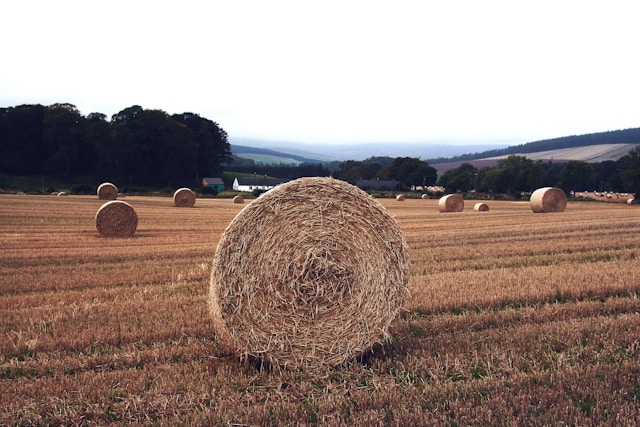
Producing premium grade hay in environments defined by drought, heat stress, erratic rainfall, or early frost demands a granular understanding of how each stressor shapes forage development. During germination, the absence of adequate soil moisture can lead to uneven emergence, creating gaps that later magnify weed pressure and inhibit uniform growth. As seedlings transition to the vegetative stage, elevated daytime temperatures accelerate respiration rates, diminishing carbohydrate reserves that drive leaf area expansion—directly eroding the crude protein levels sought in premium grade hay.
Throughout the bud and bloom phases, heat waves can disrupt enzyme activity essential for nitrogen fixation in legumes like alfalfa, further depressing protein content. Conversely, unexpected cold snaps during flowering risk flower abortion, which increases stem-to-leaf ratios, reduces palatability, and lowers relative feed value. Even wind events and high solar radiation exacerbate transpiration rates, causing stomatal closure and constraining photosynthesis.
To navigate these complex interactions, growers must map historical weather patterns, monitor seasonal anomaly forecasts, and leverage localized microclimate data. By doing so, they can predict stress windows and adjust management—such as shifting planting dates or altering cutting schedules—to protect the early growth flush, which accounts for a substantial portion of overall hay quality.
Selecting Resilient Varieties for Premium Grade Hay
At the heart of dependable premium grade hay yields lies the genetic potential of chosen cultivars. Breeding programs now focus on drought and heat tolerance traits without sacrificing forage quality. For instance, alfalfa varieties like ‘CUF 101’ and ‘WL 712’ incorporate enhanced root depth and osmotic adjustment, enabling them to extract moisture from deeper soil layers and maintain turgor under moisture deficits.
In parallel, modern timothy and orchardgrass strains exhibit increased leaf reflectance and improved cuticular wax composition, which together reduce heat load on leaf surfaces and sustain photosynthetic efficiency. When evaluating seed options, it is vital to select certified varieties proven in official performance trials that mirror your region’s stress profile. Mixing grasses with legumes—such as festulolium with alfalfa—further fortifies stand resilience, as diverse root architectures access water at multiple depths and different soil horizons.
This diversity also stabilizes nutrient uptake, ensuring that successive cuttings retain the consistent protein and fiber metrics that define premium grade hay. Finally, consider disease-resistant lines to reduce the need for chemical interventions, thereby safeguarding plant vigor when environmental stress compounds pathogen pressure.
Precision Soil and Water Management for Premium Grade Hay
Soil health underpins every facet of premium grade hay production, especially in water-limited systems. Annual soil testing reveals pH imbalances, nutrient shortfalls, and salinity levels that can hamper root development and water uptake. Optimizing soil pH to a slightly acidic range (6.5–7.0) maximizes nutrient solubility and encourages beneficial microbial activity.
Incorporating organic amendments—such as composted manure, green manure cover crops, or biochar—elevates soil organic matter, which boosts cation exchange capacity and enhances moisture retention during dry spells. In irrigated operations, implementing a deficit irrigation strategy—applying roughly 80–90% of full evapotranspiration demand—encourages deeper root penetration, which in turn stabilizes moisture access when water is scarce. Real-time soil moisture sensors integrated with evapotranspiration data models allow precise scheduling, minimizing waste and preventing waterlogged zones that can trigger root diseases.
Transitioning from overhead sprinklers to drip or subsurface drip irrigation systems slashes evaporation losses, particularly during peak insolation hours. For rainfed fields, earthwork techniques like contour swales, micro-basins, and soil-profile ripping help harvest sporadic rainfall and channel it toward root zones. These holistic soil and water practices build a buffer against climatic extremes, setting the stage for premium grade hay to flourish even under stress.
Harvest Timing, Quality Assurance, and Market Positioning of Premium Grade Hay
The final path to achieving premium grade hay extends beyond the field. Harvesting at the optimal maturity stage—early bloom for alfalfa and late boot for cool-season grasses—locks in peak crude protein and optimal fiber digestibility. Compressing the interval between cuttings to 4–5 weeks preserves favorable leaf-to-stem ratios, although it requires close labor coordination and flexible equipment deployment.
Immediately after cutting, rapid drying to a target bale moisture of 15–18% is crucial; slow curing exposes forage to mold and nutrient leaching. Using high-capacity, high-compression balers minimizes trapped oxygen, enhancing aerobic stability for long-term storage. A robust on-farm quality assurance program involves sampling every cutting for crude protein, neutral detergent fiber (NDF), acid detergent fiber (ADF), and relative feed value (RFV). Recording these laboratory results alongside yield data allows data-driven refinements to cutting heights, nutrient inputs, and harvest schedules. Each bale should be labeled with the cutting date, field block, and key quality metrics, delivering transparency to buyers.
This traceability is especially appealing to premium hay customers—such as dairies, performance horse operations, and organic livestock farms—who often pay a 10–20% price premium for certified, consistent forage. By coupling agronomic precision with targeted marketing that highlights sustainable water use, soil-health stewardship, and documented quality, growers can secure premium-grade contracts and reinforce their farm’s reputation as a reliable source of top-tier hay.
By integrating an in-depth understanding of local climate challenges, selecting genetically resilient varieties, deploying precision soil and water management techniques, and enforcing meticulous harvest and quality-control protocols, producers can consistently deliver premium grade hay in even the most demanding environments. This comprehensive approach not only safeguards yield and nutrition but also empowers growers to command premium market prices, turning climatic adversity into a pathway for agricultural excellence.